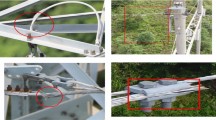Abstract
The timely replacement of in-service overhead electrical conductors in a distribution network is crucial for the reliable operation of the grid. Visually inspecting the conductors is a non-destructive testing method that can quickly identify sign of damage and degradation on the conductor’s surface and the result is used to inform decision in the risk management framework. In this study, a deep neural network is employed to classify a conductor’s condition into multiple classes ranked by the type and severity of the degradation. The best test accuracy of 83.02% was reached. This model can be used to improve on the current manually-intensive and time consuming inspection practice commonly used in the electrical distribution industry.
This project is funded by the R &D Fellowship Grants from New Zealand Callaghan Innovation, and is in partnership with and sponsored by Unison Networks Ltd. https://www.unison.co.nz/.
Access this chapter
Tax calculation will be finalised at checkout
Purchases are for personal use only
Similar content being viewed by others
References
EPRI. Parameters that influence the aging and degradation of overhead conductors. Technical report, EPRI (2003)
Graham, M., et al.: Distribution overhead copper conductors, their condition and risk-based replacement. Electricity Engineers’ Association (2021)
Naranpanawe, L., et al.: A practical health index for overhead conductors: experience from Australian distribution networks. IEEE Access 8, 218863–218873 (2020). https://doi.org/10.1109/ACCESS.2020.3042486. ISSN 2169-3536
Van der Maaten, L., Hinton, G.: Visualizing data using t-SNE. J. Mach. Learn. Res. 9(11) (2008)
Selvaraju, R.R., et al.: Grad-CAM: visual explanations from deep networks via gradient-based localization. In: Proceedings of the IEEE International Conference on Computer Vision, pp. 618–626 (2017)
Ishino, R., Tsutsumi, F.: Detection system of damaged cables using video obtained from an aerial inspection of transmission lines. In: IEEE Power Engineering Society General Meeting, vol. 2, pp. 1857–1862 (2004). https://doi.org/10.1109/PES.2004.1373201
Zhang, Y., et al.: A recognition technology of transmission lines conductor break and surface damage based on aerial image. IEEE Access 7, 59022–59036 (2019). https://doi.org/10.1109/ACCESS.2019.2914766. ISSN 2169-3536
Huang, X., et al.: A method of transmission conductor-loosened detect based on image sensors. IEEE Trans. Instrum. Meas. 69(11), 8783–8796 (2020). https://doi.org/10.1109/TIM.2020.2994475
Song, Y., Wang, H., Zhang, J.: A vision-based broken strand detection method for a power-line maintenance robot. IEEE Trans. Power Deliv. 29(5), 2154–2161 (2014). https://doi.org/10.1109/TPWRD.2014.2328572. ISSN 1937-4208
Glorot, X., Bengio, Y.: Understanding the difficulty of training deep feedforward neural networks. In: AISTATS. JMLR Proceedings, vol. 9, pp. 249–256. JMLR.org (2010)
Goodfellow, I., Bengio, Y., Courville, A.: Deep Learning. MIT Press, Cambridge (2016). https://www.deeplearningbook.org
Müller, R., Kornblith, S., Hinton, G.E.: When does label smoothing help? In: Advances in Neural Information Processing Systems, vol. 32 (2019)
Krizhevsky, A., Sutskever, I., Hinton, G.E.: Imagenet classification with deep convolutional neural networks. In: Proceedings of the 25th International Conference on Neural Information Processing Systems - Volume 1, NIPS 2012, Lake Tahoe, Nevada, pp. 1097–1105. Curran Associates Inc. (2012)
Iandola, F.N., et al.: Squeezenet: Alexnet-level accuracy with 50x fewer parameters and \(< 0.5\) MB model size (2016). https://doi.org/10.48550/ARXIV.1602.07360
Szegedy, C., et al.: Going deeper with convolutions. In: 2015 IEEE Conference on Computer Vision and Pattern Recognition (CVPR), pp. 1–9 (2015). https://doi.org/10.1109/CVPR.2015.7298594
He, K., et al.: Deep residual learning for image recognition. In: 2016 IEEE Conference on Computer Vision and Pattern Recognition (CVPR), pp. 770–778 (2016). https://doi.org/10.1109/CVPR.2016.90
Sandler, M., et al.: Mobilenetv 2: inverted residuals and linear bottlenecks. In: Proceedings of the IEEE Conference on Computer Vision and Pattern Recognition, pp. 4510–4520 (2018)
Szegedy, C., et al.: Inception-v4, inception-resnet and the impact of residual connections on learning. In: Thirty-First AAAI Conference on Artificial Intelligence (2017)
Springenberg, J.T., et al.: Striving for simplicity: the all convolutional net. In: Bengio, Y., LeCun, Y. (eds.) 3rd International Conference on Learning Representations, ICLR 2015, San Diego, CA, USA, 7–9 May 2015, Workshop Track Proceedings (2015). https://arxiv.org/abs/1412.6806
Acknowledgement
The authors would like to thank Unison Networks Limited for their technical supports and regular feedback, and the entire project team for their efforts and times to collect, curate, and label the datasets.
Author information
Authors and Affiliations
Corresponding author
Editor information
Editors and Affiliations
Rights and permissions
Copyright information
© 2023 The Author(s), under exclusive license to Springer Nature Switzerland AG
About this paper
Cite this paper
Pan, Z., Wilson, D., Stommel, M., Castellanos, A. (2023). Assessing the Condition of Copper Conductors Using Deep Learning. In: Yan, W.Q., Nguyen, M., Stommel, M. (eds) Image and Vision Computing. IVCNZ 2022. Lecture Notes in Computer Science, vol 13836. Springer, Cham. https://doi.org/10.1007/978-3-031-25825-1_13
Download citation
DOI: https://doi.org/10.1007/978-3-031-25825-1_13
Published:
Publisher Name: Springer, Cham
Print ISBN: 978-3-031-25824-4
Online ISBN: 978-3-031-25825-1
eBook Packages: Computer ScienceComputer Science (R0)




